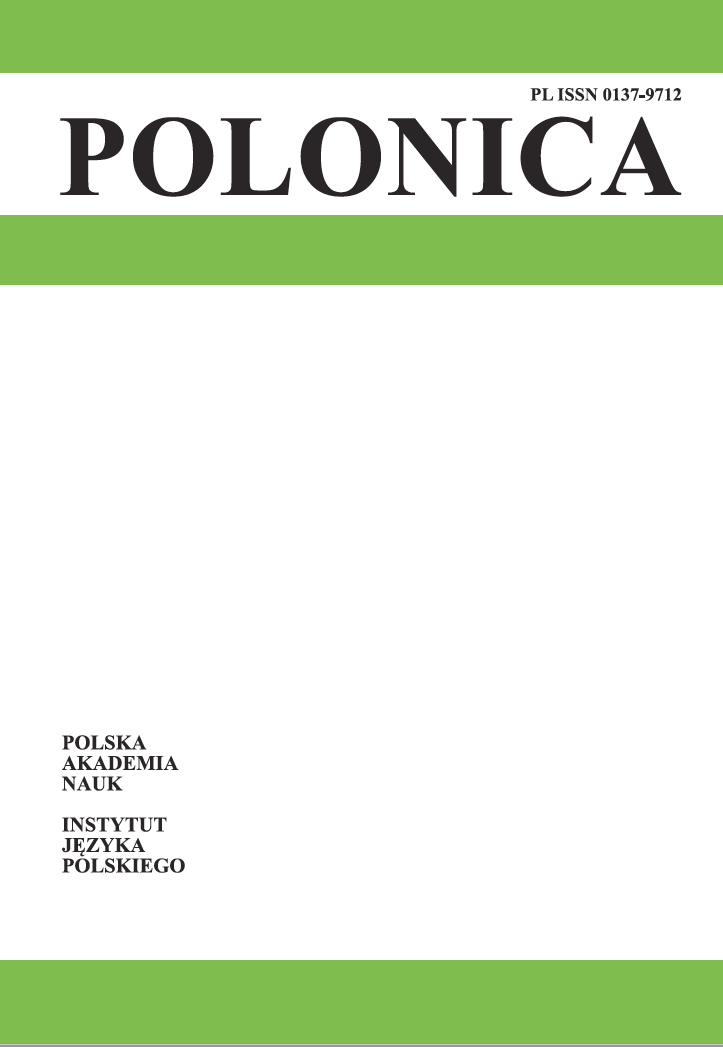Abstrakt
Deaf and hearing children of deaf parents acquire naturally sign language at the levels of phonology, morphology, syntax and pragmatics. In this article we describe the process of children’s sign development at the level of phonology. On the basis of the sign language structure theory of W. Stokoe, a pioneer researcher of sign linguistics, we distinguish three parameters acquired by children: location (place of articulation), hand configuration (shape of the hand) and movement (hand action). The acquisition of sign phonology is proceed according the rules, whose existence are approved by proper use of parameters and errors at the certain level of sign phonology development. In sign phonology acquisition we can find nonmarked parameters, which are earlier produced by children, distinct, less complex and most frequently occurring in adults utterances; and marked parameters which appear later in child development.
Bibliografia
Battison R., 1978, Lexical borrowing in American Sign Language, Burtonsville.
Bonvillian J., Siedlecki T., 2000, Young children’s acquisition of the formational aspects of American Sign Language signs: Parental report findings, Sign Language Studies 1, s. 45–64.
Boyes Braem P., 1990, Acquisition of the handshape in American Sign Language: a preliminary analysis, [w:] From Gesture to Language in Hearing and Deaf Children, red. V. Volterra, C. J. Erting, Washington, s. 107–127.
Conlin K., Mirus G., Mauk C., Meier R., 2000, The acquisition of first sign place, handshape and movement, [w:] Language Acquisition by Eye, red. C. Chamberlain, J. Morford, R. Mayberry, Mahwah, s. 51–69.
Emmorey K., 2002, Language, cognition, and the brain. Insights from sign language research, Mahwah, London.
Januszewicz M., 2014, Wyrażenia lokatywne i klasyfikatory w polskim języku migowym (PJM), [w:] Deaf sudies w Polsce, red. M. Sak, Łódź, s. 142–155.
Karnopp L.B., 2002, Phonology acquisition in Brazilian Sign Language, [w:] Directions in Sign Language Acquisition, red. G. Morgan, B. Woll, Amsterdam, Philadelphia, s. 29–53.
Kielar-Turska M., 2008, Stefan Szuman – artysta i uczony, [w:] S. Szuman, Wybór pism estetycznych, Kraków, s. VIII–XXVIII.
Kotowicz J., 2015, Nabywanie języka migowego – dyskusja stanowisk, General and Professional Edu�- cation 1, s. 26–36.
Kotowicz J., Woll B., Herman R., Kielar-Turska M., Schromová M., Łacheta J., 2015, Polish Sign Language and executive function in deaf bilingual children in late childhood, plakat zaprezentowany na: International Conference on Sign Language Acquisition, University of Amsterdam, 1–3.07-2015.
Łozińska S., 2014, Język migowy jako przedmiot badań, [w:] Lingwistyka przestrzeni i ruchu. Komunikacja migowa a metody korpusowe, red. P. Rutkowski, S. Łozińska, Warszawa, s.11–24.
Mann W., Marshall C.R., Mason K., Morgan G., 2010, The acquisition of Sign Language: The impact of phonetic complexity on phonology, Language Learning and Development 6(1), s. 60–86.
Marentette P., Mayberry R.I., 2000, Principles for an emerging phonological system: A case study of acquisition of ASL, [w:] Language Acquisition by Eye, red. C. Chamberlain, J. Morford, R. I. Mayberry, Mahwah, s. 71–90.
Marentette P., 1995, It’s in her hands: A case study of the emergence of phonology in American Sign Language, Doctoral dissertation, McGill University, Montreal.
Meier R., 2008, Modality and Language Acquisition: Resources and Constraints in Early Sign Learning, [w:] Sign Languages: spinning and unraveling the past, present and future. TISLR9, forty-five papers and three posters from the 9th. Theoretical Issues in Sign Language Research Conference, Florianopolis, Brazil, December 2006, red. R. M. de Quadros, Petrópolis, s. 325–346.
Morgan G., 2006, Children are just lingual: The development of phonology in British Sign Language (BSL), Lingua 116(10), s. 1507–1523.
Morgan G., Barrett-Jones S., Stoneham H., 2007, The first signs of language: phonological development in British Sign Language. Applied Psycholinguistics 28, s. 3–22.
Orfanidou E., Adam R., McQueen J., Morgan G., 2009, Making sense of nonsense in British Sign Language (BSL): The contribution of different phonological parameters to sign recognition, Journal of Memory and Cognition 37, s. 302–315.
PfauR., Quer J., 2010, Nonmanuals: Their grammatical and prosodic roles, [w:] Sign languages, red. D. Brentari, Cambridge, s. 381–402.
Rutkowski P., Łozińska S., Filipczak J., Łacheta J., Mostowski P., 2014, Jak powstaje korpus polskiego języka migowego (PJM)?, Polonica 33, s. 297–308.
Sandler W.,1989, Phonological representation of the sign: linearity and non-linearity in ASL phonology. Dordrecht.
Stokoe W., 2005, Sign language structure. An outline of the visual communication systems of the American Deaf, Journal of Deaf Studies and Deaf Education 10(1), s. 3–37.
Świdziński M., 2005, Języki migowe, [w:] Podstawy neurologopedii, red. T. Gałkowski, E. Szeląg, G. Jastrzębowska, Opole, s. 679–692.
Tarwacka A., Tomaszewski P., Szymańska J., Bokus B., 2014, Deaf children building narrative texts. Effect of adult-shared vs. nonshared perception of a picture story, Psychology of Language and Communication 18 (2), s. 149–177.
Tomaszewski P., 2003, Przyswajanie języka migowego przez dziecko głuche rodziców głuchych, Przegląd Psychologiczny 46(1), s. 101–128.
Tomaszewski P., 2010, Fonologia wizualna Polskiego Języka Migowego, Warszawa.
Tomaszewski P., Rosik P., 2002, Czy Polski Język Migowy jest prawdziwym językiem?, [w:] Człowiek wobec ograniczeń. Niepełnosprawność, komunikowanie, diagnoza, terapia, red. G. Jastrzębowska, Z. Tarkowski, Lubin, s. 133–165.
